Key Takeaways
Hello Heart Hero. If you're navigating the world of heart health and feeling a bit overwhelmed, you've come to the right place. We know the healthcare journey can be confusing, and sometimes you might feel skeptical or unheard. This guide is designed to feel more like a friendly conversation than a dry medical lecture.
We're going to walk through exactly what cardiac monitoring is, breaking down the concepts into simple, easy-to-understand terms.
Think of it as a special tool that lets you and your doctor listen in on your heart's unique story. It helps catch everything from the quietest rhythm changes to bigger patterns that might otherwise go completely unnoticed.
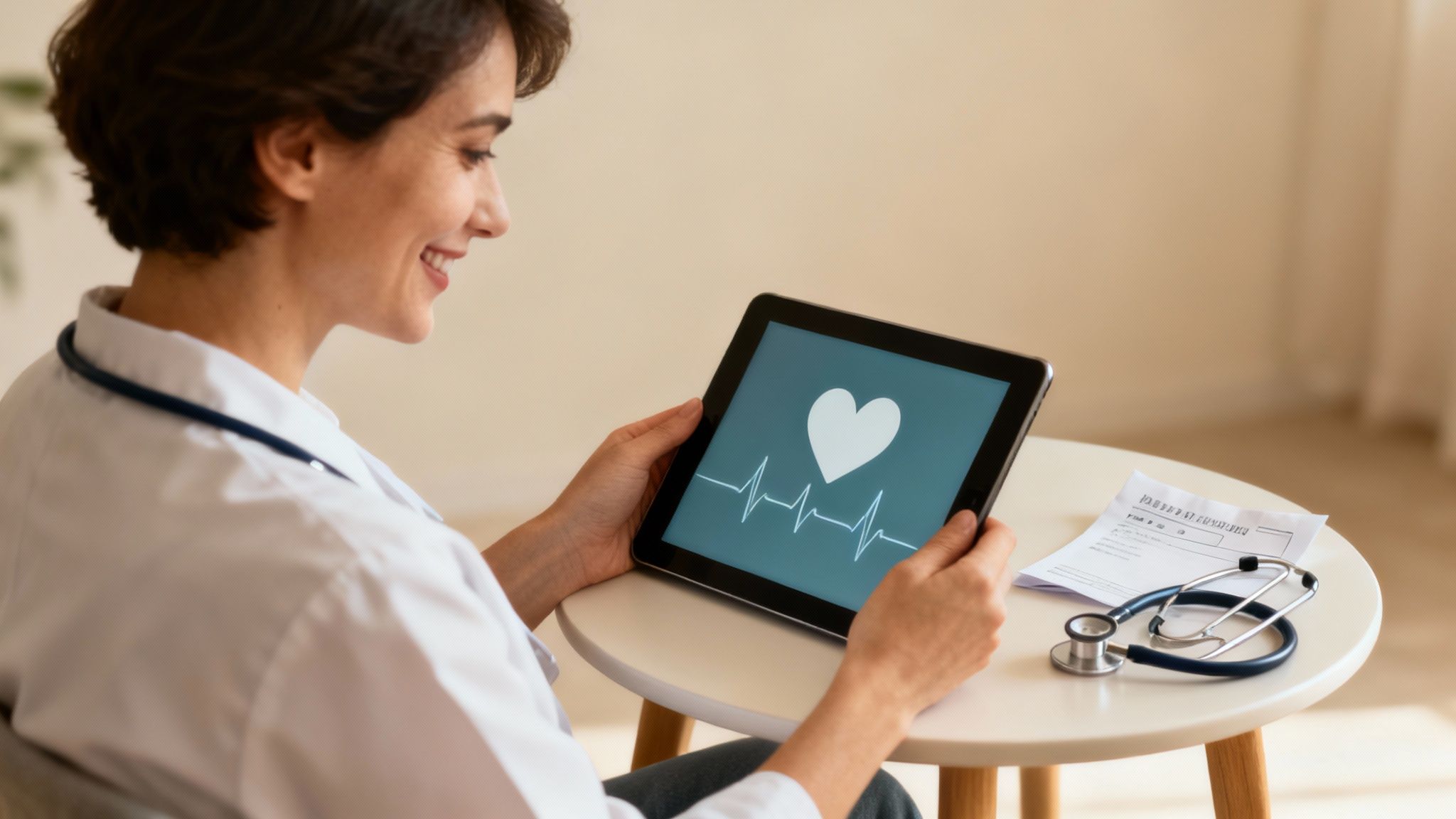
This shift toward personal health tech isn't just a trend; it's a huge movement. The global market for cardiac monitoring was recently valued at around USD 22.8 billion and is expected to climb to USD 35.2 billion by 2035. This growth, tracked by firms like Future Market Insights, shows a clear demand for more immediate and accessible healthcare.
Listening to Your Heart's Story
Your heart communicates through tiny electrical signals, creating that familiar "lub-dub" rhythm. But sometimes, that rhythm can shift. At its core, cardiac monitoring is simply the practice of tuning into these electrical signals to better understand what your heart is trying to tell you.
This isn't just about finding problems; it's about gaining clarity and peace of mind. For many, the traditional cycle of scheduling appointments and waiting for test results can feel slow and disconnected from everyday life. Monitoring offers a more personal, direct way to stay informed and take back some control.
The whole process is built on understanding your heart's electrical system, a fascinating field known as cardiac electrophysiology.
Cardiac monitoring empowers you to become an active participant in your own health journey. Instead of passively waiting for answers, you can gather the very information needed to find them.
This shift toward personal health awareness is bigger than ever. The global market for these technologies was valued at over USD 26 billion and is growing fast, proving that more and more people want to take control of their well-being.
This growth is fueled by people just like you, individuals looking for smarter, more responsive ways to manage their health. The goal is to feel confident and in control, armed with clear, straightforward information. No confusing jargon, just the answers you need to move forward.
How Does Cardiac Monitoring Work?
Your heart has a unique rhythm, a personal drumbeat that tells the story of your health. Cardiac monitoring is the incredible technology that lets us listen in on that beat. But how does it actually work?
It's simpler than you might think. There are two main ways to tune into your heart: one in a formal clinical setting, and the other right from the comfort of your own home.
We know that navigating the healthcare system can feel impersonal and slow at times, which is why understanding your options is so empowering. Both paths give you valuable information, but they work in slightly different ways. Think of it like recording a song. You can head to a professional studio for a perfectly produced track, or you can use a high-quality microphone at home to capture moments of inspiration as they happen.
The Clinical Approach: A Professional Recording Session
When your doctor needs a detailed, uninterrupted snapshot of your heart's activity, they'll likely suggest clinical monitoring. The most common tool for this job is the Holter monitor.
This is like booking that professional recording session for your heart. A technician places a few sticky sensors, called electrodes, on your chest. These are connected to a small, portable device you'll wear continuously for 24 to 48 hours as you go about your normal life, while it records every single heartbeat.
This method is incredibly thorough. It's designed to catch those subtle rhythm changes or infrequent symptoms that might not show up during a quick check-up in the doctor's office. When the time is up, you return the device, and a specialist analyzes all that data to build a complete picture of your heart's performance.
At-Home Monitoring: Your Personal Microphone
Now, let's talk about the option that puts the power directly in your hands: at-home cardiac monitoring. If clinical monitoring is a scheduled recording session, think of at-home monitoring as having your own personal microphone, ready to go the moment you feel something is off.
This is where devices like smartwatches and personal ECG readers come in. They let you capture your heart's rhythm on demand, whenever and wherever you are. This is perfect for catching those fleeting palpitations or dizzy spells that always seem to vanish by the time you can get to a clinic.
At-home monitoring gives you control. It transforms you from a passive patient waiting for an appointment into an active partner in your own health, gathering real-time data that matters.
Ultimately, both paths serve the same goal: understanding your heart. For a deeper dive into what a "normal" heart rhythm looks like on these devices, check out our guide on understanding your normal cardiac rate. Whether clinical or at-home, these methods provide crucial insights to help you and your doctor make the best decisions on your health journey.
What Are the Different Types of Heart Monitors?
The world of heart monitors can seem a bit technical, but let's pull back the curtain. It’s a lot less complicated than it sounds, and knowing the lay of the land empowers you to have much better conversations about your own health.
The key to all of this is the electrocardiogram, or ECG (sometimes called an EKG). Think of an ECG as a simple test that listens to your heart's electrical "spark plugs." Each time your heart beats, it gives off tiny electrical signals. A monitor's job is to catch these signals and draw them out as a picture, revealing your heart's rhythm.
This straightforward process is the foundation for every type of cardiac monitoring, whether it happens in a hospital or right from your own wrist.
This infographic breaks down the two main worlds of cardiac monitoring: the devices you get from a clinic and the ones you can use at home.
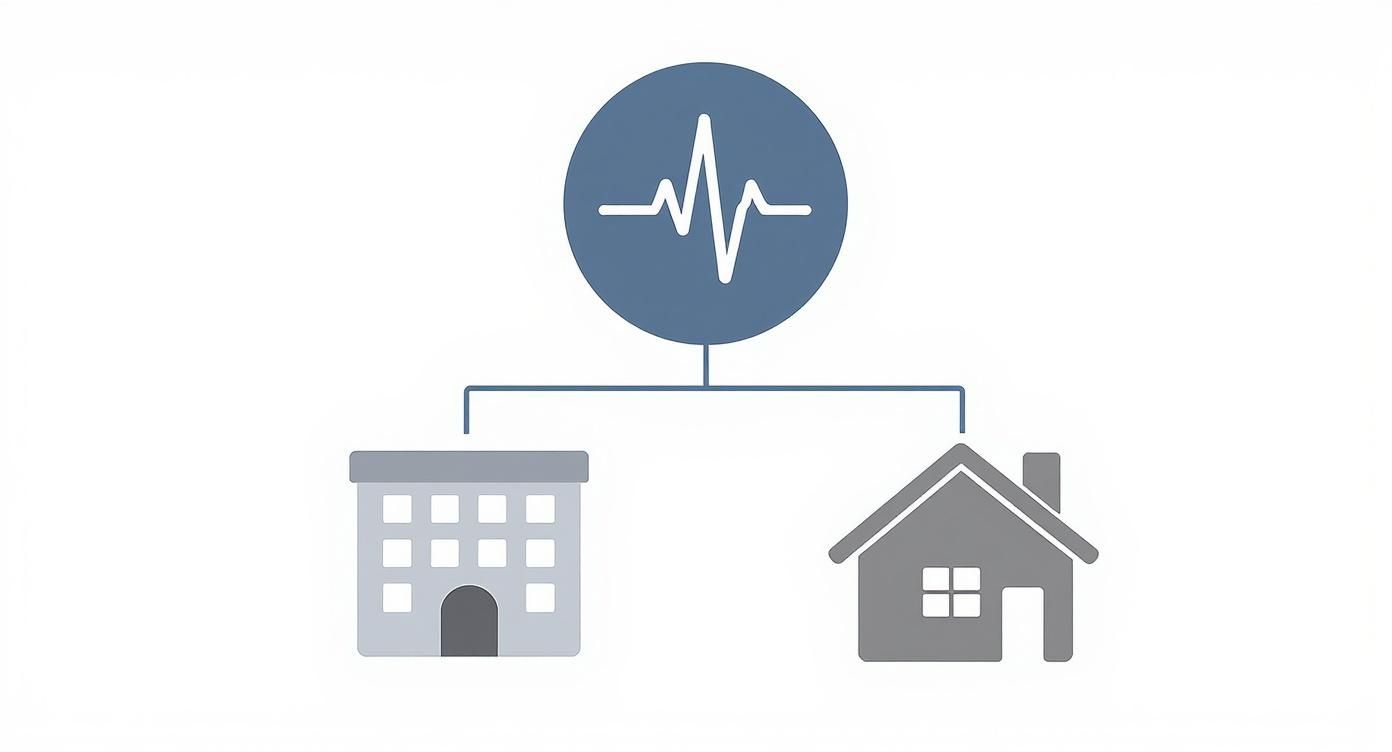
As you can see, the journey to understanding your heartbeat can start either in a doctor's office or in your living room. Each path offers its own unique advantages.
Clinical Monitors: The Doctor's Toolkit
When your doctor needs a deep dive into your heart's activity over a day or more, they'll likely turn to a clinical-grade monitor. These are prescribed devices designed for highly detailed, continuous recording.
The two most common you'll encounter are:
- Holter Monitors: This is a small, wearable recorder you typically wear for 24 to 48 hours. It connects to several sticky sensors (electrodes) on your chest and records every single heartbeat during that period. It’s the classic tool for catching rhythm issues that pop up unpredictably.
- Event Monitors: An event monitor is a bit different. You might wear it for a longer stretch, like a few weeks, but it only records when you tell it to. If you feel a symptom like a flutter or lightheadedness, you simply press a button to capture your heart’s electrical activity at that exact moment.
While these devices provide a massive amount of data for your doctor, they do require appointments, fittings, and then a wait for the results to come back.
Personal ECGs: The Power in Your Hands
This brings us to the modern era of smartwatches and personal ECG devices, which have put incredible technology right at our fingertips. If you’ve ever felt frustrated by the slow pace of traditional healthcare, this is where you can take a more active role.
These at-home tools let you take an ECG on demand, whenever you feel something isn't quite right. Their tiny sensors are remarkably good at capturing your heart's electrical signals. This is a huge deal because many heart rhythm irregularities are fleeting. They often vanish by the time you can get in to see a doctor.
Having a personal ECG means you no longer have to just describe your symptoms to your doctor. You can show them the actual data of what your heart was doing in that moment, giving them a clear and actionable piece of information.
The ability to capture these fleeting moments is invaluable. For many people, a quick ECG reading can provide instant peace of mind or deliver the concrete data needed to seek further care. If you're curious to learn more, you can explore the details of how a portable electrocardiogram monitor works. Ultimately, every type of monitor, whether clinical or personal, serves a unique purpose in helping you listen to your heart's story.
Why At-Home Cardiac Monitoring Is a Game Changer
The ability to check on your heart from the comfort of your home is a massive leap forward. If you've ever felt a bit lost or frustrated with the traditional path of scheduling appointments and waiting for answers, this shift toward personal health monitoring is a big deal. It gives you a sense of control that can be incredibly comforting when you're worried about your health.
This isn't just about fancy new gadgets. It’s a fundamental change in how we manage our own health. We're moving away from a system where we wait for a doctor's appointment to find out what's going on, and toward a proactive model where we can check in whenever we feel the need. This puts you firmly in the driver's seat.
From Waiting Room to Living Room
Think about those symptoms that come and go in a flash: a sudden flutter in your chest, a dizzy spell, or a racing heartbeat that's gone as quickly as it started. It's so common for these things to never happen when you’re actually in the doctor’s office. Trying to describe a sensation that’s no longer there can be tough, sometimes leaving you feeling like you weren't truly heard.
This is exactly where at-home cardiac monitoring makes all the difference. You can capture real data the instant you feel a symptom. Instead of just saying, "I felt a weird flutter yesterday," you can show your doctor the actual ECG recording of what your heart was doing at that exact moment. This data gives you and your doctor a clear, objective starting point for a much more productive conversation.
At-home monitoring bridges the gap between feeling a symptom and understanding it. It provides the proof you need to advocate for yourself, turning vague concerns into concrete, actionable information.
This proactive approach doesn't just empower you; it helps make the whole healthcare process more efficient. When you come to an appointment with clear data, you help your doctor make more informed decisions, faster. It’s a win-win that builds a genuine partnership between you and your healthcare provider.
The Power of Personal Health Data
Having your heart data right at your fingertips does more than just provide medical information; it can bring a huge amount of peace of mind. Just knowing you can take an ECG anytime you feel anxious can, in itself, help reduce that anxiety. It's a tool for reassurance, letting you quickly check if a strange feeling is something to worry about or just a normal blip.
This sense of empowerment is fueling huge growth in the health tech space. Remote cardiac monitoring, the practice of gathering heart data outside of a clinic, is expanding fast. The global market was valued at USD 3.80 billion and is expected to more than double, reaching USD 10.66 billion by 2034. This trend shows just how much people want to take an active role in their own health.
This isn't just a small market for tech enthusiasts; it's a major shift in how we think about personal health. The benefits are obvious:
- Immediate Feedback: You don't have to wait days or weeks for an appointment to get an initial look at your heart's rhythm.
- Symptom Correlation: You can finally connect how you feel physically to actual heart rhythm data, giving crucial context to your symptoms.
- Long-Term Tracking: By monitoring over time, you and your doctor can spot patterns or changes that a single office visit would likely miss.
- Increased Engagement: Actively monitoring your own health often motivates you to make other positive lifestyle changes.
If you're wondering how to get started, our guide on how to check heart health at home provides some practical first steps. This whole movement is about making health information more accessible and putting powerful tools directly into your hands.
Making Sense of Your ECG Readings with Qaly
Okay, so you just took an ECG with your smartwatch. Now what? You're probably staring at a screen full of squiggly lines that look confusing, maybe even a little scary. This is that critical moment where raw data needs to become real understanding, and it’s exactly where Qaly comes in.
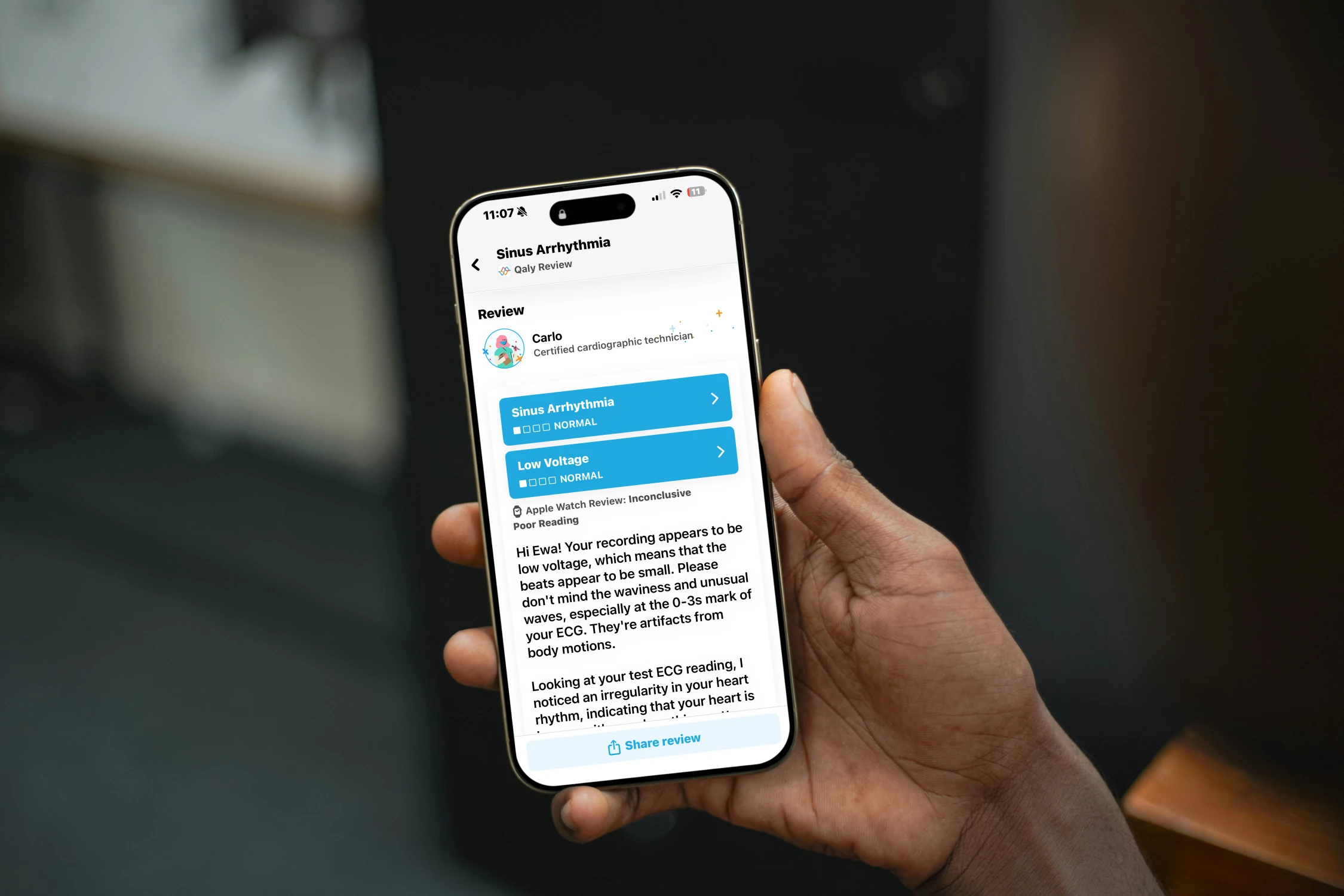
Think of the Qaly app as a friendly, expert translator for your heart's electrical language. It’s designed to close the gap between seeing your ECG and truly knowing what it means, giving you clear answers without the long wait for a doctor's appointment.
We get it. That feeling of uncertainty when looking at your own health data is real. That's why the process with Qaly is built to be simple and reassuring, turning a moment of doubt into a moment of clarity.
How Qaly Turns Squiggles into Sense
The journey from confusion to confidence is surprisingly fast. It’s a simple, direct process that puts an expert analysis right in your hands, often in less time than it takes to brew your morning coffee. The goal here isn't to replace your doctor, but to arm you with reliable information so you can have a more productive conversation with them.
Here’s the breakdown:
- You Take an ECG: Use your Apple Watch, Fitbit, Kardia, or another compatible device to record your ECG whenever you feel a symptom or just want to check in.
- Share It with Qaly: Pop open the Qaly app on your phone and securely share the ECG you just recorded. It's as easy as sending a photo to a friend.
- Get an Expert Interpretation: Within minutes, your ECG is reviewed by a certified, US-based cardiographic technician. No algorithms working alone here; a trained human expert analyzes your heart's unique rhythm.
- Receive a Clear Report: You'll get a notification with a straightforward, easy-to-understand interpretation of your ECG. You'll know if the rhythm looks normal or if something like an arrhythmia was detected.
This quick turnaround is what makes at-home cardiac monitoring so powerful. You get immediate peace of mind or the clear data you need to decide on your next step.
More Than Just a Reading
Qaly does more than just interpret a single ECG. It helps you see the bigger picture of your heart health over time, all from your smartphone. This deeper insight is what helps you spot patterns and have much better conversations with your doctor.
For example, the app helps you track important heart metrics. It gives you instant PR, QRS, and QTc interval readings, key measurements of your heart’s electrical cycle. Following these numbers over time can give you and your doctor valuable clues about your heart's condition.
Qaly transforms your at-home ECG from a simple snapshot into a meaningful health record. It empowers you to collect and understand your heart's data, making you a more effective advocate for your own well-being.
This service is really about building confidence. When you have a reliable place to turn for answers, you can cut down on the anxiety that often comes with unexplained symptoms. You learn what’s normal for you and can quickly spot when something might need a doctor's attention.
Ultimately, understanding your own ECG readings is a huge part of modern cardiac monitoring. With a service like Qaly, you’re no longer just collecting data. You're gaining the knowledge to be an active participant in your own heart health journey.
Taking an Active Role in Your Heart Health
Deciding to understand your own heart is a huge first step. If you’ve ever felt like your concerns weren't fully heard, or you just wanted a bit more control within a confusing healthcare system, that feeling is completely understandable. The most important thing to know is you’re not in this by yourself.
Modern approaches to health are finally putting powerful tools right into your hands. This lets you shift from being a passive patient to an active, informed partner in your own care. It's technology like at-home cardiac monitoring, especially when combined with expert analysis from services like Qaly, that makes this possible.
This shift is a big deal. It means you can start gathering your own health data, on your own time.
Your Journey Is About Progress, Not Perfection
Every single heartbeat tells a piece of your story. Learning to listen to it is one of the most powerful things you can do for your well-being. This isn’t about being perfect or never worrying again. It’s about making steady, meaningful progress in understanding what your body is telling you.
Every small step you take to monitor your heart is a win. Each time you capture an ECG when you feel a symptom, you’re collecting another crucial piece of your personal health puzzle. This proactive approach gives you a solid foundation for better, more informed conversations with your doctor and a real sense of control.
This journey is about progress, not perfection. Every small step you take to monitor and understand your heart is a victory for your long-term health and peace of mind.
This isn't about replacing your doctor; it's about making your relationship with them stronger. When you can walk into an appointment with clear, personal data, you're helping your medical team see the complete picture. You become a key part of the diagnostic process, making sure your concerns are backed up by real information.
Ultimately, taking an active role in your heart health is one of the best investments you can make in your future. It's about swapping anxiety for answers and trading uncertainty for empowerment. Each ECG, each reading, and each piece of data you gather helps build a stronger, more confident you.
Frequently Asked Questions About Cardiac Monitoring
Diving into the world of cardiac monitoring can bring up a lot of questions. That's totally normal, especially when it's about your own health. Let's clear up some of the common ones to help you feel more comfortable and confident.
Is At-Home Cardiac Monitoring as Accurate as a Hospital ECG?
This is a fantastic question and one we hear all the time. The short answer is that they serve different, but equally valuable, purposes.
Your smartwatch gives you what's called a "single-lead" ECG. It's incredibly good at detecting rhythm problems, like Atrial Fibrillation, right as they happen. A hospital, on the other hand, uses a "12-lead" ECG, which gives a complete, 360-degree electrical picture of your heart.
Think of it like this: your watch is a security camera pointed at your front door, perfect for seeing who's coming and going (your heart's rhythm). A 12-lead hospital ECG is a full security system with cameras covering every angle of your house, inside and out. Both are useful, but they're designed for different jobs. For catching those fleeting rhythm issues in your daily life, your at-home device is a powerful and accurate tool.
How Can I Share My At-Home ECG Results with My Doctor?
Most smartwatches and personal ECG devices make sharing your data incredibly simple. The companion app on your phone usually lets you generate a PDF of your ECG reading with just a few taps.
You can then email this PDF directly to your doctor's office or even print a copy to bring to your next appointment. This is a game-changer for having a more informed and productive conversation about what you're experiencing.
Services like Qaly take this a step further by providing clear, expert-interpreted reports that are perfect for sharing. These reports turn a confusing squiggle into a clear piece of information, giving your doctor immediate context.
Will I Feel Anything When Using a Cardiac Monitor?
No, not at all. The entire process is completely non-invasive and painless.
Whether you’re using a clinical Holter monitor with sticky electrodes or a smartwatch with a sensor on the back, the device is simply "listening" to the natural electrical signals your heart produces on its own. You won’t feel any zaps, shocks, or strange sensations. The most you might notice is the feeling of the adhesive pads on your skin if you're wearing a clinical monitor for a few days, but the monitoring itself is totally passive.
Get clear, human-verified ECG results from certified technicians in minutes, turning your health data into real understanding and peace of mind.
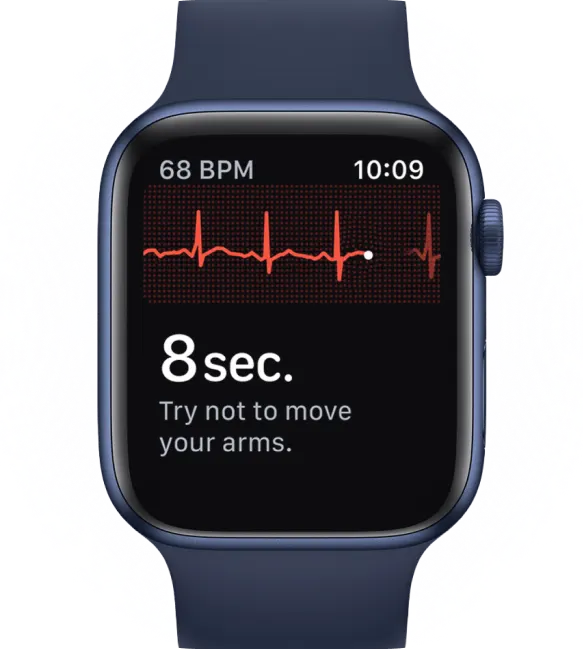


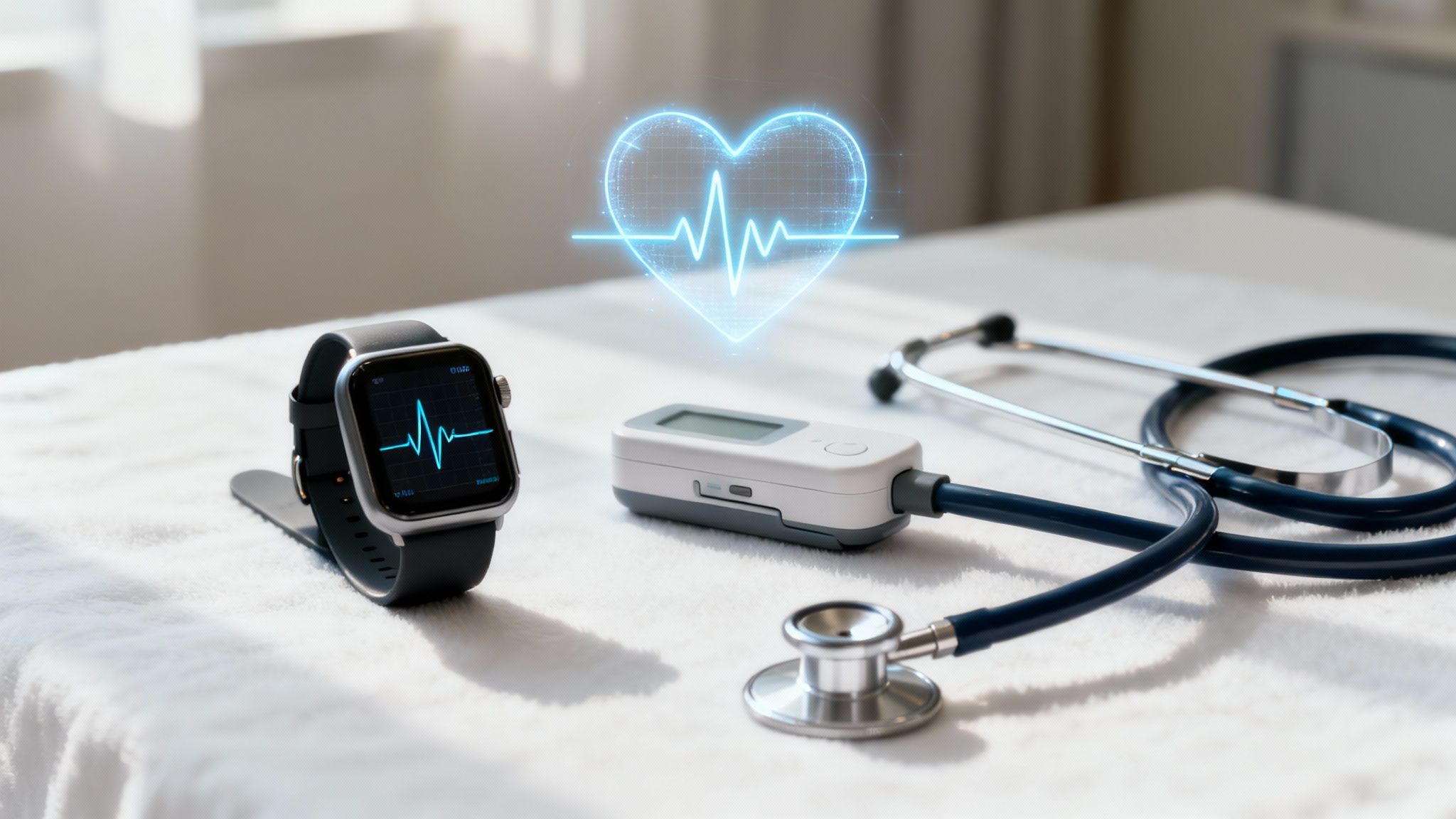






.png)
.png)